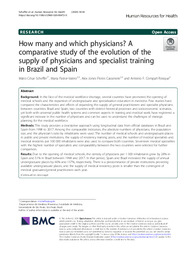Título :
How many and which physicians? A
comparative study of the evolution of the
supply of physicians and specialist training
in Brazil and Spain |
Autor :
Scheffer, Mário César
Pastor-Valero, Maria 
Cassenote, Alex 
Compañ Rosique, Antonio F.  |
Editor :
World Health Organization |
Departamento:
Departamentos de la UMH::Salud Pública, Historia de la Ciencia y Ginecología |
Fecha de publicación:
2020-04 |
URI :
https://hdl.handle.net/11000/30543 |
Resumen :
Abstract
Background: In the face of the medical workforce shortage, several countries have promoted the opening of
medical schools and the expansion of undergraduate and specialization education in medicine. Few studies have
compared the characteristics and effects of expanding the supply of general practitioners and specialist physicians
between countries. Brazil and Spain, two countries with distinct historical processes and socioeconomic scenarios,
yet both with universal public health systems and common aspects in training and medical work, have registered a
significant increase in the number of physicians and can be used to understand the challenges of strategic
planning for the medical workforce.
Methods: This study provides a descriptive approach using longitudinal data from official databases in Brazil and
Spain from 1998 to 2017. Among the comparable indicators, the absolute numbers of physicians, the population
size, and the physician’s ratio by inhabitants were used. The number of medical schools and undergraduate places
in public and private institutions, the supply of residency training posts, and the number of medical specialists and
medical residents per 100 000 inhabitants were also used to compare both countries. Seventeen medical specialties
with the highest number of specialists and comparability between the two countries were selected for further
comparison.
Results: Due to the opening of medical schools, the density of physicians per 1 000 inhabitants grew by 28% in
Spain and 51% in Brazil between 1998 and 2017. In that period, Spain and Brazil increased the supply of annual
undergraduate places by 60% and 137%, respectively. There is a predominance of private institutions providing
available undergraduate places, and the supply of medical residency posts is smaller than the contingent of
medical graduates/general practitioners each year.
Conclusion:
Both countries have similar specialist densities in cardiology, dermatology, and neurosurgery specialties. However, family medicine and community in Spain has 91.27 specialists per 100 000 inhabitants, while in Brazil, the density is only 2.64. The comparative study indicated the complexity of the countries’ decisions on increasing the medical supply of general practitioners and specialist physicians. Research and planning policies on the medical workforce must be aligned with the actual health needs of populations and health systems.
|
Palabras clave/Materias:
Healthcare workforce
Physician workforce
Physician supply
Residency training |
Área de conocimiento :
CDU: Ciencias aplicadas: Medicina |
Tipo documento :
application/pdf |
Derechos de acceso:
info:eu-repo/semantics/openAccess
Attribution-NonCommercial-NoDerivatives 4.0 Internacional |
DOI :
https://doi.org/10.1186/s12960-020-00472-0 |
Aparece en las colecciones:
Artículos Salud Pública, Historia de la Ciencia y Ginecología
|
 La licencia se describe como: Atribución-NonComercial-NoDerivada 4.0 Internacional.
La licencia se describe como: Atribución-NonComercial-NoDerivada 4.0 Internacional.
.png)
